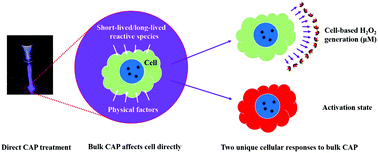Cold atmospheric plasma cancer treatment, direct versus indirect approaches
Abstract
Cold atmospheric plasma (CAP), an ionized gas with near room temperature, shows a wide application in medicine. CAP is a tunable source of complex chemical components including many reactive species, which allows CAP to exert many biological effects on bacterial, fungal, yeast, and mammalian cells particularly cancer cells. In this review, we discuss the novel state of the art CAP-based cancer treatment. We focus on the comparison between the direct CAP treatment and the indirect CAP treatment which implements the use of CAP-activated solutions. The difference between the two treatment strategies reveals two unique features of the biological response to CAP: the cell-based H2O2 generation and the activation phenomenon. Short-lived reactive species and physical factors from plasma may trigger these two cellular responses.



 Please wait while we load your content...
Please wait while we load your content...